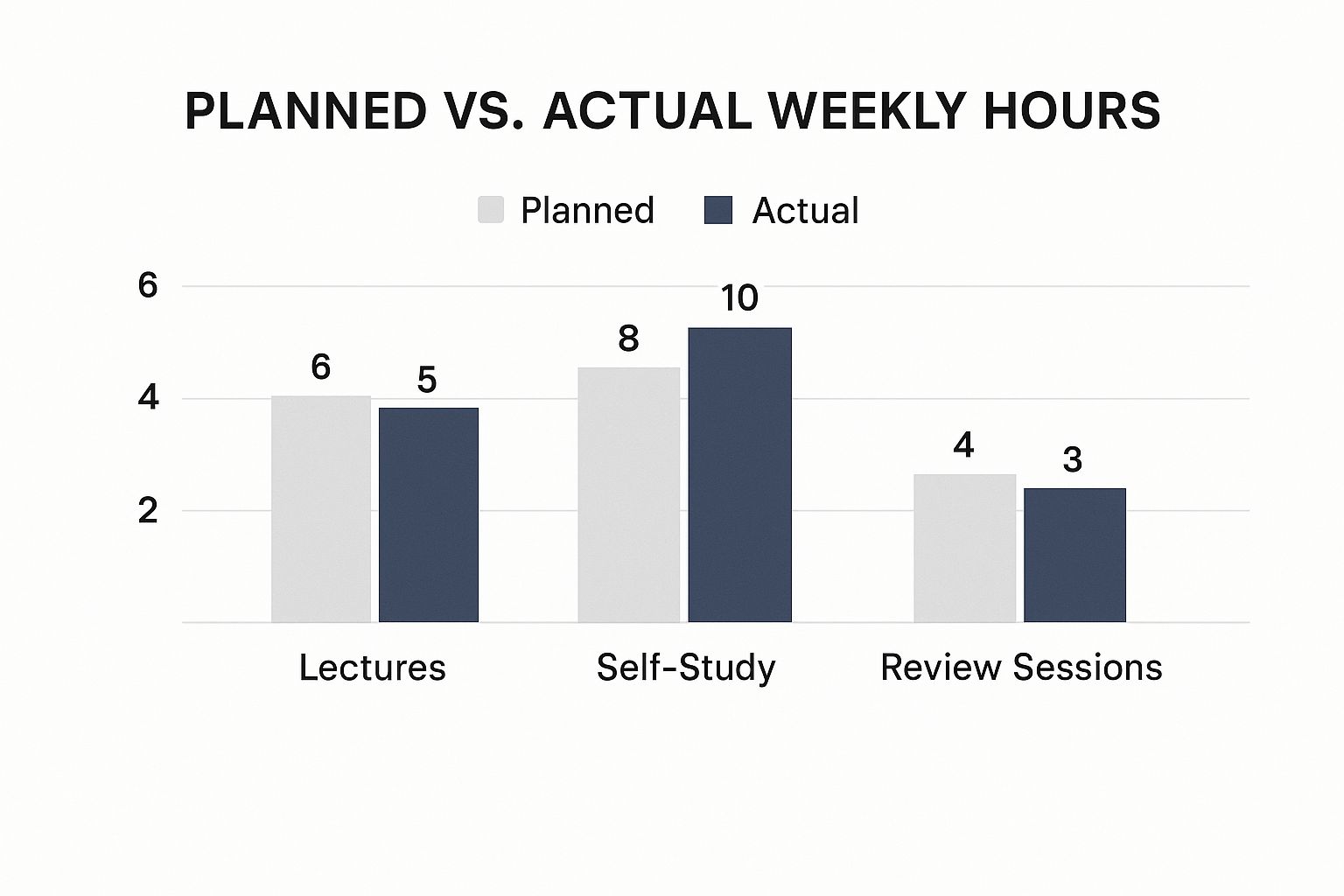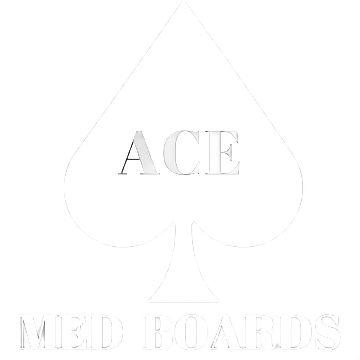A winning study schedule for medical students isn’t a magic template you download online. It’s a personalized system you build from the ground up, one that respects the insane workload of med school while fitting your unique life. It means ditching generic planners and embracing high-yield, active learning from day one.
Why Generic Study Templates Fail in Med School
Let’s be real. The whole “drinking from a firehose” analogy? It’s an understatement. The only way to survive the sheer volume of information is to study smarter, not just longer. This is exactly why a one-size-fits-all study schedule is destined to crash and burn.
Think about it. Your learning style, your energy levels, your life outside of med school—these are non-negotiable. A schedule that works for your classmate, the morning person who learns by drawing elaborate diagrams, will be a total disaster for you if you’re a night owl who lives and breathes by flashcards.
Moving Beyond Passive Review
The single biggest trap students fall into is packing their schedules with passive activities. Re-reading notes, highlighting textbooks, or watching lecture videos on repeat feels productive, but it’s a lie. It gives you a false sense of familiarity without any real understanding.
True mastery comes from active learning, which forces your brain to struggle a bit to retrieve and apply what you’ve learned.
This is the bedrock of an effective study schedule for medical students. Instead of blocking out three hours to “Study Cardiology,” you need to schedule specific, active tasks that make your brain work.
- Active Recall: Hammering out practice questions without peeking at your notes.
- Spaced Repetition: Using tools like Anki to review concepts at intervals designed to beat the forgetting curve.
- The Feynman Technique: Trying to explain a complex topic, like the renin-angiotensin-aldosterone system, in simple terms a kid could understand.
Your goal is to build a personalized framework that puts these high-impact methods front and center. It’s about setting yourself up for deep comprehension and long-term success, not just barely surviving until the next exam.
Quality Over Quantity
It’s tempting to buy into the myth that all-nighters are a rite of passage for getting ahead. But the data—and my experience—tells a different story. Consistent, focused effort is far more powerful.
For instance, a 2019 study of medical students revealed that the highest achievers weren’t the ones pulling 12-hour study marathons. They were more likely to study for a manageable 3 to 4 hours daily. What set them apart? Rock-solid time management, minimizing distractions, and having crystal-clear goals. You can dig into the full study about student habits and GPA correlation on PMC.
At the end of the day, your schedule has to be built around your life, not the other way around. This means doing a full, honest audit of your current habits and energy patterns before you even think about opening a calendar. Building this foundation is the most critical step you can take, especially when you’re also staring down the barrel of major exams. In fact, these principles are the absolute core of building a winning USMLE Step 1 study plan.
A schedule that acknowledges you’re a human who needs sleep, food, and breaks is the only kind that will carry you through the marathon of medical training.
To really nail this down, it helps to start with the foundational concepts. These aren’t just abstract ideas; they are the core principles you’ll use to build a schedule that actually works for you, week after week.
Core Principles of an Effective Medical Study Schedule
| Principle | Why It Matters in Medical School | Quick Example |
|---|---|---|
| Active Recall | Forces your brain to retrieve information, strengthening memory far more than passive review. | Instead of re-reading a chapter, do a set of 20 practice questions on that topic. |
| Spaced Repetition | Interrupts the natural forgetting curve by strategically re-exposing you to material. | Using an app like Anki for 30 minutes daily to review flashcards. |
| High-Yield Focus | Acknowledges you can’t learn everything; you must prioritize the most testable concepts. | Spending 60% of your cardiology block on IHD, HF, and arrhythmias, not rare vasculitides. |
| Energy Management | Matches your most demanding tasks (like new learning) with your peak energy times. | Scheduling your UWorld blocks in the morning if that’s when you’re sharpest. |
| Flexibility | Med school is unpredictable. A rigid schedule breaks; a flexible one bends. | Building in a 2-hour “catch-up” block on Fridays for topics that took longer than expected. |
| Sustainability | Prevents burnout by incorporating breaks, sleep, and life outside of medicine. | Scheduling a non-negotiable workout 3 times a week and taking Saturday nights off. |
By building your schedule on these principles, you move from just “managing time” to strategically directing your effort where it will have the greatest impact. It’s the difference between treading water and actually swimming toward the finish line.
Building Your Weekly Study Blueprint Hour by Hour

Okay, with the big-picture principles down, it’s time to get granular. This is where the theory becomes a practical, hour-by-hour blueprint that you can actually follow. Your study schedule for medical students stops being an idea and becomes a real tool.
The method we’ll use is called time blocking. It’s all about creating a visual, repeatable weekly calendar.
First things first, you have to place your “big rocks”—these are the non-negotiable appointments that anchor your entire week. Open up Google Calendar, a physical planner, whatever you use, and block these out before you do anything else.
This includes all your scheduled class time, mandatory labs, and any clinical duties you have. And don’t forget to block out a consistent 8 hours for sleep, meal times, and your commute. These aren’t optional extras; they’re the foundation for your energy and focus.
Layering in Your Study Blocks
Once your non-negotiables are on the calendar, you’ll see the empty spaces. This is where the magic happens. These open slots are where your focused study sessions will live. The key here is to be brutally specific.
Don’t just write a vague block labeled “Study.” You have to assign a specific mission to each block. This one simple change eliminates the daily struggle of figuring out what to work on and lets you dive right in.
For example, a Tuesday morning slot isn’t just “Study.” It’s “Cardiology Practice Questions (40 Qs) + Review.” A Thursday afternoon block becomes “Draw Nephron Transporters from Memory.”
This level of detail turns your schedule from a list of nice ideas into a concrete action plan. While this weekly blueprint gives you structure, breaking it down into manageable daily tasks using effective daily planning features is what makes it work.
A well-structured schedule doesn’t just organize your time; it protects your focus. By pre-deciding what you’ll work on, you free up valuable mental energy for the actual task of learning, rather than wasting it on figuring out where to start.
Alternating Subjects to Beat Fatigue
Staring at the same dense subject for four hours straight is a fast track to burnout. Your brain craves novelty. To keep your focus sharp and your retention high, you need to alternate between different types of material throughout the day.
This cognitive “gear shifting” prevents mental exhaustion and actually improves how well you remember things. A great way to structure this is by pairing a dense, memorization-heavy topic with one that’s more conceptual or problem-based.
Sample Daily Structure:
- Morning Block 1 (90 min): Anatomy Memorization (e.g., brachial plexus pathways).
- Morning Block 2 (90 min): Physiology Concepts (e.g., cardiac output regulation).
- Afternoon Block (2 hours): Active Recall (e.g., UWorld block covering mixed topics).
This approach keeps you on your toes by engaging slightly different parts of your brain. It’s a critical strategy for building a sustainable study schedule when you’re facing the sheer breadth of a medical curriculum.
Mastering Focus with Pomodoro
Okay, so you have your blocks. But how do you stay focused within each block? The Pomodoro Technique is a game-changer for this. The method is simple but incredibly powerful: work in focused 25-minute sprints, then take a 5-minute break.
After you’ve done four of these “Pomodoros,” you take a longer, more substantial break of 15-30 minutes. This little system helps in two huge ways:
- It makes starting easier. Committing to just 25 minutes feels way less intimidating than staring down a 2-hour study block.
- It preserves your focus. The regular, short breaks are just enough to prevent the mental fatigue that leads to scrolling Instagram or zoning out.
By combining time blocking, subject alternation, and the Pomodoro Technique, you create a dynamic and powerful weekly blueprint. This schedule becomes more than just a calendar—it’s a repeatable routine that provides structure, minimizes daily decision-making, and becomes an automatic part of your path to success.
Integrating High-Yield Study Techniques

Having a beautifully structured weekly blueprint is a major win, but let’s be real—it’s only half the battle. An organized schedule is only as effective as the study methods you fill it with. This is where we shift gears from just planning your time to truly maximizing what you learn within that time.
Passive review, like rereading chapters or highlighting your notes for the fifth time, feels comfortable. It feels productive. But it builds a fragile, surface-level understanding that crumbles under pressure. True, lasting retention comes from forcing your brain to actively engage with the material. This means transforming every study block from a passive viewing session into an intense workout for your brain.
From Passive Rereading to Active Recall
Active recall is the absolute cornerstone of efficient learning in medical school. It’s the simple, yet brutally effective, act of retrieving information from your memory without looking at your notes. It feels harder than just rereading because it is harder—and that struggle is precisely what solidifies the neural pathways you need on exam day.
So, instead of just rereading the steps of the Krebs cycle, close the book. Try to draw the entire pathway from memory. Then, explain each enzymatic step out loud as if you were teaching it to a classmate who missed the lecture. The moments you stumble, hesitate, or go completely blank are the most valuable part of the whole exercise. They expose your exact knowledge gaps with surgical precision.
This isn’t just for basic sciences. When you’re reviewing a patient case, cover up the diagnosis and treatment plan. Based on the history and physical exam findings alone, try to formulate your own differential diagnosis and management strategy. That’s active recall in a clinical context.
Mastering Spaced Repetition
Your brain is wired to forget things it doesn’t see or use regularly. It’s a feature, not a bug. Spaced repetition is the technique designed to directly combat this “forgetting curve” by showing you information at increasing intervals, right at the moment you’re about to forget it.
This is where digital flashcard tools like Anki become a med student’s best friend.
- Make Your Own Cards: The very act of creating a flashcard is a form of active learning. Keep them simple and to the point: one concept or one question per card. No novels.
- Trust the Algorithm: Anki’s system is smart. It knows when you need to see a card again. Resist the temptation to manually review everything; trust the system to do its job and show you what you need, when you need it.
- Daily Consistency is King: A spaced repetition system only works if you use it consistently. Carve out 20-30 minutes every single day for your Anki reviews. It’s a small, non-negotiable block that pays massive dividends in long-term retention.
A well-implemented study schedule for medical students isn’t just about managing time; it’s about systematically managing your memory. Active recall forces you to pull information out, and spaced repetition ensures it stays there.
The intensity of this approach is backed by real-world data. One study found that top-performing medical students consistently maintained regular, intense study schedules. In fact, about 42% of ‘A’ students studied over 6 hours daily, with another 49% clocking in 3 to 5 hours. They weren’t just putting in the time; they were actively reviewing material outside of class. You can read the full research about these study habits to see the breakdown for yourself.
Using the Feynman Technique to Find Your Weak Spots
The Feynman Technique is elegantly simple: can you explain a complex topic in simple terms? If you can’t, you don’t truly understand it yet. It’s the ultimate test of comprehension.
Pick a topic—let’s say, the difference between nephrotic and nephritic syndromes. Now, pretend you’re explaining it to a friend who has zero medical background. Can you do it without falling back on jargon? Can you simplify the pathophysiology using analogies? The points where you get stuck, stumble over your words, or can’t connect the dots—that’s where your understanding is weak. That’s your signal to go back to the books.
For a deeper dive into these kinds of active learning methods, you might find our guide on effective study techniques for med students incredibly helpful.
By integrating these high-yield methods into your scheduled blocks, you ensure every single minute you spend studying is actively building and reinforcing your knowledge base. And to take it a step further, consider exploring some powerful AI tools for students that can help automate tedious tasks and boost your productivity. This approach transforms your schedule from a simple calendar into a powerful machine for learning.
That brilliant, high-intensity study schedule that got you through your first year? It won’t survive your first day of clinical rotations. A static plan is a failing plan in medical school. Your approach has to evolve right alongside the curriculum, shifting from foundational science to clinical application and, finally, to an all-out sprint for the boards.
Sticking to one rigid study schedule for medical students ignores the reality on the ground. To succeed, you have to adapt your strategy to match the unique beast you’re facing each year.
The Preclinical Years: M1 and M2
Your first two years are all about building a massive foundation of knowledge. You’re trying to drink from a firehose, juggling biochemistry, anatomy, physiology, and pathology all at once. The sheer volume is the main enemy here, so your schedule needs to be all about structure and consistency.
This is the time to get really good at time blocking and high-yield study techniques. A typical week is a whirlwind of lectures and labs, which must be followed by structured, independent study time. It’s a huge time commitment. It’s common for first-year students to spend 30 to 40 hours weekly on studying alone, and that number can easily climb depending on the curriculum’s intensity and how close you are to an exam block. You can find more details on what first-year students face at AUC School of Medicine.
Your goal is to truly master the core concepts. That means your schedule should be packed with:
- Structured Content Review: Dedicate daily blocks to reviewing that day’s lecture material. No exceptions.
- Consistent Active Recall: Make daily sessions with a spaced repetition tool like Anki non-negotiable. This is how you keep facts fresh across all your subjects.
- Weekly Synthesis: Protect time on the weekend to connect the dots between different courses—like linking the pharmacology of a drug to its physiological mechanism.
The Clinical Years: M3 and M4
The moment you hit the wards for your third-year rotations, that beautiful, color-coded schedule you perfected gets thrown right out the window. Your life is now dictated by whatever clinical service you’re on, which means long, unpredictable hours. Flexibility is now your greatest asset.
The whole focus of your learning shifts from textbook memorization to practical, case-based application. You’re studying for your Shelf exams while simultaneously trying not to be completely useless to the medical team.
Your study schedule has to be built in the margins of your day. Think short, intense bursts of learning.
- On-the-Go Learning: Get comfortable with flashcard apps on your phone. Use them during downtime between seeing patients or on your commute.
- Targeted Question Banks: Instead of broad content review, hammer practice questions specific to your current rotation. If you’re on Peds, you’re living in the Pediatrics section of UWorld.
- Case-Based Review: In the evenings, read up on the specific conditions of the patients you saw that day. This contextual learning is incredibly powerful and makes information stick.
The key takeaway for your clinical years is to shift from long, pre-planned study blocks to short, high-intensity sprints whenever you find a spare 20 minutes. Your schedule becomes less of a rigid calendar and more of a flexible to-do list of high-priority learning tasks.
This infographic really shows the gap that often exists between the hours you plan to study and the reality of a med student’s week.

As you can see, unpredictable clinical duties or lectures that run long often eat into planned study time, which is exactly why you need a flexible, adaptable schedule.
To make this crystal clear, let’s break down how your focus should change across the different phases of medical school.
Study Focus by Medical School Phase
| Phase | Primary Goal | Key Study Method | Scheduling Priority |
|---|---|---|---|
| Preclinical (M1/M2) | Foundational knowledge mastery | Structured content review, spaced repetition (Anki) | Consistency & Routine |
| Clinical (M3/M4) | Clinical application, Shelf exams | Question banks (UWorld), case-based learning | Flexibility & On-the-Go |
| Dedicated Prep | High-yield board exam content | Practice exams (NBMEs), weak area review | High-Intensity Sprints & Rest |
This table highlights the transition from building a broad base to applying that knowledge clinically, and finally, to sharpening it for a single, high-stakes exam.
The Dedicated Board Prep Sprint
Preparing for a major exam like USMLE Step 1 is its own unique beast. This isn’t a marathon spread over a year; it’s a dedicated, full-time sprint that lasts several weeks. During this period, studying is your job.
Your schedule becomes highly structured again, but with a singular, obsessive focus. You have to meticulously plan how to cover a massive amount of material while ramping up intensity and, crucially, avoiding burnout. The two pillars of a good dedicated study period are practice exams and detailed review.
A successful “dedicated” schedule has a few key components:
- Baseline Assessment: Kick things off with a full-length practice exam, like an NBME. This is crucial for identifying your weak areas from day one so you know where to focus your energy.
- System-Based Blocks: Organize your days by organ system (e.g., two days on cardiology, two on renal). This helps you integrate the physiology, pathology, and pharmacology for each system.
- Regular Practice Exams: Schedule a full-length test every one to two weeks. This simulates test day conditions, builds stamina, and lets you track your progress.
- Scheduled Rest: You have to intentionally plan for days off. A full day of rest each week isn’t a luxury; it’s a requirement to consolidate information and prevent your performance from tanking.
Scheduling Your Well-Being to Prevent Burnout

Let’s be honest: the most perfectly designed study schedule for medical students is worthless if you’re too fried to actually follow it. The sheer volume of material and constant pressure make burnout a real occupational hazard in medicine, not just some trendy buzzword. If you don’t treat your well-being with the same respect you give to biochemistry, you’re setting yourself up for a rough ride.
This means you have to intentionally carve out time for breaks, hobbies, exercise, and seeing other human beings. These aren’t just “leftovers” to squeeze in if you finish your flashcards early. They are protected, non-negotiable appointments in your calendar that fuel your ability to perform. Thinking of wellness as a luxury is a surefire way to hit a wall, hard.
Spotting the Early Warning Signs
Burnout doesn’t just show up one morning. It’s a slow burn, a creeping exhaustion that’s easy to dismiss as “just stress” until it completely takes over. Learning to see the first red flags in yourself is a crucial survival skill.
Keep an eye out for these three core symptoms:
- Overwhelming Exhaustion: This isn’t just feeling tired. It’s a deep, bone-deep physical and emotional drain that a good night’s sleep doesn’t seem to touch.
- Cynicism and Detachment: You start to feel negative or disconnected from your studies. That initial passion that got you into med school begins to feel distant and faded.
- A Sense of Ineffectiveness: You’re putting in the hours, but you feel like you’re spinning your wheels and not actually accomplishing anything. This can crush your confidence and make you question the whole endeavor.
Catching these signs early gives you a chance to pull back and make changes before they derail your mental health and your progress.
A schedule that ignores your humanity is unsustainable. The goal isn’t just to survive medical school; it’s to thrive. That means building a system that supports both your academic goals and your personal well-being.
Building Resilience into Your Schedule
Preventing burnout is an active strategy, not something that just happens. You have to bake resilience right into the framework of your weekly schedule. This isn’t about being “soft”—it’s about being smart and building the mental endurance required for a demanding career.
First things first: treat sleep as sacred. Aiming for a consistent 7-8 hours a night isn’t lazy; it’s critical for memory consolidation, focus, and keeping your emotions in check. Sacrificing sleep is one of the worst trades you can make in medical school.
Next, schedule short, frequent breaks. I’m talking a 5-10 minute break every hour to get up, stretch, or just stare out a window. It works wonders for resetting your focus. For more structured ideas, exploring some key med student time management tips can give you practical ways to integrate these pauses effectively.
Actionable Stress Management Techniques
Beyond just scheduling breaks, you need a toolkit of practical ways to manage stress when it inevitably spikes. These don’t have to take a lot of time, but you do have to practice them.
Simple Stress-Reduction Tactics
| Tactic | How It Works | Quick Example |
|---|---|---|
| Mindful Breathing | Activates your body’s “rest and digest” system, creating an immediate calming effect. | Before starting a tough block of questions, take five slow, deep breaths. Focus only on the feeling of the air. |
| Physical Activity | Flushes out stress hormones like cortisol and releases mood-boosting endorphins. | Squeeze in a brisk 20-minute walk between your afternoon study blocks to clear your head. |
| Protected Hobbies | Gives your brain a true vacation from medicine, preventing mental fatigue and burnout. | Block out two hours on Saturday for something you love—no exceptions. It could be gaming, hiking, or playing guitar. |
At the end of the day, you can’t pour from an empty cup. Scheduling time for yourself, protecting your sleep, and having go-to stress-relief strategies are fundamental parts of any high-performance study plan. This proactive approach is what ensures you have the energy and resilience to not just start strong, but to cross the finish line.
Common Questions About Med School Schedules
Even with a perfectly designed plan, med school has a way of throwing curveballs. The truth is, a great study schedule for medical students isn’t something you set in stone. It’s a living, breathing document that you have to troubleshoot and adapt.
Let’s dive into some of the most common questions I hear from students trying to wrangle their schedules.
How Many Hours a Day Should I Actually Study?
This is the million-dollar question, isn’t it? But the honest answer is there’s no magic number. It completely depends on your school’s curriculum, how efficiently you learn, and what classes you’re juggling at the moment. My best advice? Stop looking at what people post on social media and figure out what you actually need.
That said, a realistic and productive target for most successful students is 3-5 hours of focused, active studying on weekdays. This is time spent outside of your required lectures and labs. On weekends, you might block out longer sessions for more comprehensive review.
But here’s the most important part: the quality of your study time trumps the quantity, every single time. Four hours of active recall—smashing practice questions, explaining concepts out loud to your wall—is infinitely more powerful than eight hours of passively rereading your notes. The goal is deep engagement, not just time in the chair.
What Is the Best Way to Schedule for Multiple Exams?
Exam weeks are a special kind of brutal. Juggling prep for several high-stakes tests is a skill in itself, but it’s one you can definitely learn. The secret is to combine a “triage” mindset with consistent review in the weeks leading up to the storm.
First, identify which subject is your biggest beast or which exam carries the most weight for your grade. That one gets the prime real estate in your study schedule. You’re not going to abandon the others, of course, but you’ll allocate your time proportionally based on its difficulty and importance.
- Interleave Your Subjects: Your brain will thank you for this. Instead of grinding on anatomy for six hours straight, switch it up. Try 90 minutes of anatomy, take a real break, then dive into 90 minutes of biochemistry. This cognitive “gear shifting” keeps you much fresher and helps prevent burnout.
- Lean on Spaced Repetition: In the weeks before that exam cluster hits, your spaced repetition system (like Anki) is your best friend. Make sure you’re consistently keeping up with cards from all the relevant subjects. This keeps the information simmering, so you aren’t trying to cram everything from a cold start.
My Schedule Fell Apart. How Do I Get Back on Track?
First off, welcome to the club. It happens to literally everyone. A family emergency, a clinical rotation that runs late, or just plain old exhaustion can completely derail the most color-coded, well-intentioned schedule. The absolute most important thing is not to panic or throw the whole system in the trash.
Take a breath. Seriously. Before jumping back into the chaos, take 30 minutes to figure out what happened. Was it a one-off disaster, or is there a specific study block that you always seem to skip?
Perfection is the enemy of consistency. The goal of a study schedule isn’t to be followed flawlessly 100% of the time. It’s to provide a reliable structure that you can return to after inevitable disruptions. Forgive the lapse and simply start fresh with the next scheduled block.
If you spot a recurring problem—like you’re constantly snoozing through that 6 AM review session—it’s time to adjust the plan, not force yourself into a system that isn’t working. Maybe that block needs to be shorter. Maybe it needs to move to the evening. Tweak the single broken part, not the whole machine.
Should I Study with a Group or Alone?
Why not both? The most effective students I’ve seen use a hybrid approach. Solo study and group study both have unique superpowers, and the key is to use each one for the right mission.
Solo Study is for:
- First-Pass Learning: When you’re first cracking open a textbook or watching a lecture on new material, you need pure, uninterrupted focus.
- Deep Memorization: Grinding through your Anki deck or meticulously tracing nerve pathways is a solitary mission.
- Practice Questions: Doing timed UWorld blocks is all about simulating exam conditions, which means it’s just you against the clock.
Group Study is for:
- Unsticking Complex Concepts: Talking through a nightmare physiological process with others is an amazing way to find the gaps in your own understanding.
- Active Recall Drills: There’s nothing like quizzing each other to practice pulling facts out of thin air, just like you’ll have to on the exam.
- The Feynman Technique: If you can explain a topic clearly to your group, you’ve truly mastered it.
The trick to successful group sessions is to set a crystal-clear agenda beforehand. Decide exactly what topics you’re covering to keep the session from turning into a two-hour social chat. Beyond just staying disciplined, some people get a huge boost from the shared commitment. If that’s you, consider looking into the benefits of finding a study accountability partner to help keep everyone on track.
At Ace Med Boards, we know that building and maintaining the right study schedule is a dynamic, personal process. Our expert tutors work with you one-on-one to craft a plan that actually fits your learning style and adapts as med school throws new challenges your way. If you’re ready to get beyond generic templates and build a strategy that gets real results, schedule a free consultation with us today at https://acemedboards.com.

